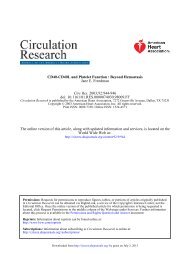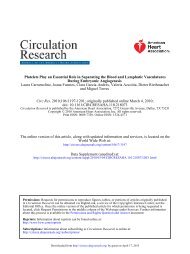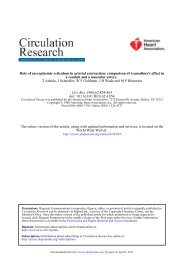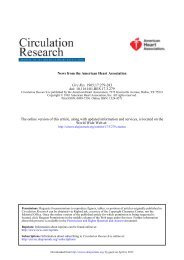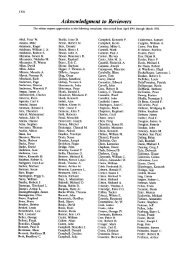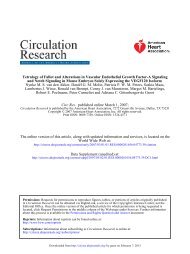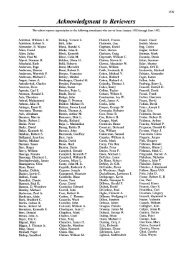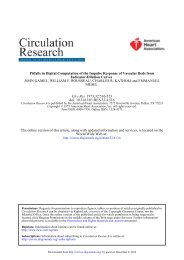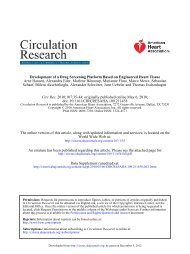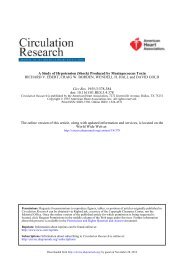UltraRapid Communication - Circulation Research
UltraRapid Communication - Circulation Research
UltraRapid Communication - Circulation Research
You also want an ePaper? Increase the reach of your titles
YUMPU automatically turns print PDFs into web optimized ePapers that Google loves.
Vascular Superoxide Production by NAD(P)H Oxidase : Association With Endothelial<br />
Dysfunction and Clinical Risk Factors<br />
Tomasz J. Guzik, Nick E. J. West, Edward Black, Denise McDonald, Chandi Ratnatunga, Ravi<br />
Pillai and Keith M. Channon<br />
Circ Res. 2000;86:e85-e90<br />
doi: 10.1161/01.RES.86.9.e85<br />
<strong>Circulation</strong> <strong>Research</strong> is published by the American Heart Association, 7272 Greenville Avenue, Dallas, TX 75231<br />
Copyright © 2000 American Heart Association, Inc. All rights reserved.<br />
Print ISSN: 0009-7330. Online ISSN: 1524-4571<br />
The online version of this article, along with updated information and services, is located on the<br />
World Wide Web at:<br />
http://circres.ahajournals.org/content/86/9/e85<br />
Data Supplement (unedited) at:<br />
http://circres.ahajournals.org/content/suppl/2000/05/05/86.9.e85.DC1.html<br />
Permissions: Requests for permissions to reproduce figures, tables, or portions of articles originally published<br />
in <strong>Circulation</strong> <strong>Research</strong> can be obtained via RightsLink, a service of the Copyright Clearance Center, not the<br />
Editorial Office. Once the online version of the published article for which permission is being requested is<br />
located, click Request Permissions in the middle column of the Web page under Services. Further information<br />
about this process is available in the Permissions and Rights Question and Answer document.<br />
Reprints: Information about reprints can be found online at:<br />
http://www.lww.com/reprints<br />
Subscriptions: Information about subscribing to <strong>Circulation</strong> <strong>Research</strong> is online at:<br />
http://circres.ahajournals.org//subscriptions/<br />
Downloaded from<br />
http://circres.ahajournals.org/ by guest on January 29, 2013
Vascular Superoxide Production by NAD(P)H Oxidase<br />
Association With Endothelial Dysfunction and Clinical Risk Factors<br />
Tomasz J. Guzik, Nick E.J. West, Edward Black, Denise McDonald, Chandi Ratnatunga,<br />
Ravi Pillai, Keith M. Channon<br />
Abstract—Superoxide anion plays important roles in vascular disease states. Increased superoxide production contributes to<br />
reduced nitric oxide (NO) bioactivity and endothelial dysfunction in experimental models of vascular disease. We measured<br />
superoxide production by NAD(P)H oxidase in human blood vessels and examined the relationships between NAD(P)H<br />
oxidase activity, NO-mediated endothelial function, and clinical risk factors for atherosclerosis. Endothelium-dependent<br />
vasorelaxations and direct measurements of vascular superoxide production were determined in human saphenous veins<br />
obtained from 133 patients with coronary artery disease and identified risk factors. The predominant source of vascular<br />
superoxide production was an NAD(P)H-dependent oxidase. Increased vascular NAD(P)H oxidase activity was associated<br />
with reduced NO-mediated vasorelaxation. Furthermore, reduced endothelial vasorelaxations and increased vascular<br />
NAD(P)H oxidase activity were both associated with increased clinical risk factors for atherosclerosis. Diabetes and<br />
hypercholesterolemia were independently associated with increased NADH-dependent superoxide production. The association<br />
of increased vascular NAD(P)H oxidase activity with endothelial dysfunction and with clinical risk factors suggests an<br />
important role for NAD(P)H oxidase–mediated superoxide production in human atherosclerosis. The full text of this article<br />
is available at http://www.circresaha.org. (Circ Res. 2000;86:e85-e90.)<br />
Key Words: atherosclerosis � endothelium � superoxide � nitric oxide � diabetes<br />
Superoxide production by vascular tissues and its interaction<br />
with nitric oxide may play important roles in<br />
vascular disease pathophysiology. 1,2 Superoxide reacts rapidly<br />
with nitric oxide (NO), reducing NO bioactivity and<br />
producing peroxynitrite, 3,4 a strong oxidant that can nitrosylate<br />
cellular proteins and lipoproteins. 5 Recent evidence<br />
suggests that increased superoxide production accounts for a<br />
significant proportion of the NO deficit in several animal<br />
models of vascular disease, including hypercholesterolemia,<br />
6,7 hypertension, 8–10 and heart failure. 11 In addition to<br />
effects mediated by scavenging NO, superoxide directly<br />
stimulates mitogenesis in vascular smooth muscle cells12,13 and reduces endothelial NO synthase expression and activity<br />
in endothelial cells. 14<br />
Potential sources of vascular superoxide production include<br />
NAD(P)H-dependent oxidases, 8,15 xanthine oxidase, 6,16<br />
lipoxygenase, mitochondrial oxidases, and NO synthases. 17<br />
The NAD(P)H oxidase, originally characterized in neutrophils,<br />
is present in vascular smooth muscle cells15,18 and<br />
endothelial cells19–21 and is the principal source of superoxide<br />
production in some animal models of vascular disease. 7,8<br />
Furthermore, p22phox, one of the components of the<br />
NAD(P)H oxidase, is expressed in atherosclerotic human<br />
coronary arteries. 22 Genetic polymorphisms in the CYBA<br />
<strong>UltraRapid</strong> <strong>Communication</strong><br />
gene, encoding p22phox, have recently been associated with<br />
coronary artery disease in case-control studies and in a<br />
prospective study of coronary artery disease progression or<br />
regression. 23 Despite the potential importance of superoxide<br />
production by the NAD(P)H oxidase in atherosclerosis,<br />
functional studies of human vascular superoxide production<br />
have been limited and have not investigated NAD(P)H<br />
oxidase activity. 24,25 Consequently, the relationships between<br />
superoxide production by NAD(P)H oxidase, atherosclerotic<br />
risk factors, and endothelial dysfunction in human blood<br />
vessels remain unclear.<br />
Accordingly, we sought to investigate the importance of<br />
NAD(P)H oxidase in human vascular superoxide production,<br />
with the use of saphenous veins from patients with systemic<br />
risk factors for atherosclerosis. We find that an NAD(P)H<br />
oxidase is the principal source of superoxide production in<br />
human saphenous veins and that increased vascular<br />
NAD(P)H oxidase activity is associated with impaired NOmediated<br />
endothelial function and with increased atherosclerotic<br />
risk factor profile.<br />
Materials and Methods<br />
Patients<br />
Segments of human saphenous veins were obtained from patients<br />
undergoing routine coronary artery bypass surgery at the John<br />
Received April 7, 2000; accepted April 11, 2000.<br />
From the Departments of Cardiovascular Medicine (T.J.G., N.E.J.W., D.M., K.M.C.) and Cardiothoracic Surgery (E.B., C.R., R.P.), University of<br />
Oxford, John Radcliffe Hospital, Oxford, UK.<br />
Correspondence to Keith M. Channon, Department of Cardiovascular Medicine, University of Oxford, John Radcliffe Hospital, Oxford OX3 9DU, UK.<br />
E-mail keith.channon@cardiov.ox.ac.uk<br />
© 2000 American Heart Association, Inc.<br />
<strong>Circulation</strong> <strong>Research</strong> is available at http://www.circresaha.org<br />
Downloaded from<br />
http://circres.ahajournals.org/ 1 by guest on January 29, 2013
2 <strong>Circulation</strong> <strong>Research</strong> May 12, 2000<br />
Radcliffe Hospital, Oxford, UK. The collection of tissue specimens<br />
was approved by the local research ethics committee. Clinical risk<br />
factors were categorized as follows: hypercholesterolemia (total<br />
plasma cholesterol level �4.8 mmol/L); smoking (current or within<br />
last 6 months); diabetes (fasting glucose level �5.5 mmol/L or<br />
current treatment with insulin or oral hypoglycemic agents); and<br />
hypertension (current treatment with antihypertensive agents).<br />
Vasomotor Studies<br />
Vasomotor responses to phenylephrine, acetylcholine (ACh), calcium<br />
ionophore, and sodium nitroprusside (SNP) were determined as<br />
previously described. 26 All experiments were performed in the<br />
presence of indomethacin (10 �mol/L). Responses were expressed as<br />
a percentage of the maximal contraction or precontracted tension.<br />
Vascular Superoxide Production<br />
Superoxide production was measured by lucigenin-enhanced chemiluminescence,<br />
according to previously described and validated<br />
methods. 6,8,27,28 Vessel segments were equilibrated in oxygenated<br />
Krebs-HEPES solution for 30 minutes at 37°C. Lucigenin-enhanced<br />
chemiluminescence from intact vessels was measured in buffer (2<br />
mL) containing lucigenin (5 �mol/L), 27,28 then NADH (100 �mol/L)<br />
or other substrates were added. In other experiments, chemiluminescence<br />
was measured in vascular homogenates, in buffer containing<br />
lucigenin (250 �mol/L), as previously described. 7,8 Vascular homogenates<br />
were separated into soluble (cytosolic) and particulate<br />
(membrane-associated) fractions by ultracentrifugation, as previously<br />
described. 29 Superoxide production was expressed as relative<br />
light units (RLU) � s �1 � mg vessel dry weight �1 or RLU � s �1 � �g<br />
protein �1 .<br />
We measured NADH-stimulated superoxide production in both<br />
vascular homogenates and intact rings prepared from the same<br />
patients (n�30) and found a significant correlation (r�0.7,<br />
P�0.001), suggesting that either approach provides an equivalent<br />
measure of NAD(P)H oxidase activity.<br />
The lucigenin-based assay was validated against an independent<br />
measure of superoxide production using superoxide dismutase<br />
(SOD)-inhibitable ferricytochrome c reduction, as previously described.<br />
30 Equilibrated vessel rings or portions of vascular homogenate<br />
were incubated in 1 mL of buffer containing ferricytochrome c<br />
(80 �mol/L) at 37°C for 45 minutes, then absorbance was measured<br />
at 550 nm. Similar experiments were performed in the presence of<br />
NADH (100 �mol/L). All experiments were performed in parallel<br />
with and without SOD (400 U/mL). Superoxide-dependent ferricytochrome<br />
c reduction was calculated as the portion of ferricytochrome<br />
c reduction inhibited by SOD. NADH-stimulated superoxide<br />
production measured by ferricytochrome c reduction from both intact<br />
vessels and vascular homogenates was closely correlated with<br />
measurements determined in parallel by lucigenin-enhanced chemiluminescence<br />
(intact vessels: n�9; r�0.91, P�0.0001; homogenates:<br />
r�0.94, P�0.001).<br />
Statistical Analysis<br />
Data are expressed as mean�SEM. Vasomotor responses are the<br />
average of a mean 3.4 rings for each patient; in all cases n refers to<br />
numbers of patients. Statistical significance of differences between<br />
superoxide production in response to different substrates or inhibitors<br />
was assessed by Student’s t tests. Correlation between vasorelaxations<br />
and superoxide production was assessed by simple linear<br />
regression. Association between vasorelaxations and number of<br />
clinical risk factors was assessed by Spearman’s rank correlation<br />
coefficient and between superoxide production and individual risk<br />
factors using multiple ANOVA (type III sums of squares). A value<br />
of P�0.05 was considered significant.<br />
An expanded Materials and Methods section is available online at<br />
http://www.circresaha.org.<br />
Results<br />
Patient Characteristics<br />
Saphenous vein was obtained from 133 patients (107 men, 26<br />
women) undergoing coronary artery bypass grafting. Demo-<br />
graphic and clinical characteristics are shown in Table 1. All<br />
patients had at least one clinical risk factor for atherosclerosis,<br />
and all patients had been administered multiple drug<br />
therapy.<br />
Superoxide Generation From Human<br />
Saphenous Veins<br />
Basal superoxide production was determined by lucigeninenhanced<br />
chemiluminescence from intact vessel rings. Specificity<br />
for superoxide was demonstrated by coincubation with<br />
either SOD (350 U/mL) or tiron (10 mmol/L). Superoxide<br />
production was greatly reduced by diphenyleneiodonium, an<br />
inhibitor of flavin-containing oxidases (Table 2). In contrast,<br />
neither oxypurinol, rotenone, nor N-methyl-L-arginine significantly<br />
inhibited superoxide production. The addition of<br />
NADH (100 �mol/L) stimulated superoxide release �10fold;<br />
NADH-stimulated superoxide release was inhibited also<br />
by diphenyleneiodonium but not by oxypurinol, rotenone, or<br />
N-methyl-L-arginine (Table 2). Because NADH has been<br />
reported to stimulate activity of extracellular xanthine oxidase,<br />
we measured superoxide release from intact vessel rings<br />
in response to hypoxanthine. There was no significant increase<br />
in superoxide release in the presence of 1 mmol/L<br />
hypoxanthine (n�8; basal 8.2�0.9 versus hypoxanthine<br />
9.3�2.3 RLU � s �1 � mg �1 ; P�NS). We investigated also<br />
superoxide release by vascular homogenates in the presence<br />
of substrates for specific oxidases (Figure 1A). Again, the<br />
greatest stimulation of superoxide production was generated<br />
by NADH. NADPH produced �25% of the stimulation seen<br />
with NADH. In contrast, neither succinate nor hypoxanthine<br />
stimulated superoxide production by vascular homogenates.<br />
To further characterize this vascular NADH-dependent<br />
oxidase activity, we determined the specific activity of the<br />
enzyme in subcellular fractions of saphenous vein homogenates<br />
generated from intact vessels and from vessels denuded<br />
of endothelium (Figure 1B). NADH-dependent superoxide<br />
production was reduced by �40% in vascular homogenates<br />
prepared after endothelial denudation, suggesting that endo-<br />
TABLE 1. Clinical and Demographic Characteristics of Patients<br />
Age (year; mean�SEM)<br />
Number, %<br />
64�0.8<br />
Sex (M:F)<br />
Risk Factors<br />
107:26<br />
Smoking 50 (38)<br />
Hypertension 97 (73)<br />
Diabetes mellitus 32 (24)<br />
Hypercholesterolemia<br />
Medication<br />
88 (66)<br />
�-blockers 80 (60)<br />
Aspirin 115 (86)<br />
Nitrates 70 (65)<br />
Lipid-lowering agents 106 (80)<br />
Calcium antagonists 69 (52)<br />
Angiotensin-converting enzyme inhibitors 61 (46)<br />
Numbers in parentheses are percentages of total number.<br />
Downloaded from<br />
http://circres.ahajournals.org/ by guest on January 29, 2013
TABLE 2. Characteristics of Vascular Superoxide Release<br />
Superoxide Production,<br />
RLU � s �1 � mg �1<br />
Basal �NADH<br />
Vessel alone 22.4�3.4 350�31.8<br />
�Diphenyleneiodonium 6.6�1.7* 94.3�13.4*<br />
�Oxypurinol 19.1�4.3 371�39.3<br />
�Rotenone 20.8�2.7 341�35.5<br />
�SOD 7.2�2.8* 165�24.9*<br />
�Tiron 5.9�1.0* 80.5�8.9*<br />
�N-methyl-L-arginine<br />
Data are mean�SEM.<br />
26.2�3.9 448�70.6<br />
Superoxide production was determined in multiple saphenous vein rings<br />
from 13 patients by lucigenin-enhanced chemiluminescence (5 �mol/L lucigenin)<br />
in the presence or absence of various inhibitors of oxidase systems<br />
(diphenyleneiodonium 100 �mol/L, oxypurinol 100 �mol/L, rotenone 100<br />
�mol/L, or N-methyl-L-arginine 1 mmol/L) or scavengers of superoxide (SOD<br />
350 U/mL or tiron 10 mmol/L). Vessel rings were incubated with these agents<br />
for 30 minutes before and during superoxide determination. Other rings were<br />
stimulated with NADH (100 �mol/L), with or without incubation with inhibitors.<br />
*P�0.05 vs vessel ring alone.<br />
thelium contains a substantial proportion of NADHstimulated<br />
oxidase activity. Subcellular fractionation of homogenates<br />
by ultracentrifugation into soluble (cytosolic) and<br />
particulate (membrane) fractions revealed that �99% of the<br />
NADH-stimulated oxidase activity was localized in the particulate<br />
fraction.<br />
Taken together, these data suggest that a membraneassociated<br />
NAD(P)H-dependent oxidase, rather than xanthine<br />
oxidase, mitochondrial oxidases, or NO synthase, is the<br />
predominant source of superoxide production in human<br />
saphenous veins from patients with atherosclerosis.<br />
Endothelial Vasomotor Function in Human<br />
Saphenous Veins<br />
We used isometric vasomotor studies to investigate NO<br />
bioactivity in saphenous vein segments. Maximal endotheli-<br />
Figure 1. Superoxide production by vascular homogenates.<br />
Segments of saphenous vein were homogenized, and superoxide<br />
production was determined by lucigenin-enhanced chemiluminescence.<br />
A, Response to potential oxidase substrates:<br />
no substrate added (Basal), NADH (100 �mol/L), NADPH<br />
(100 �mol/L), succinate (Succ, 5 mmol/L), and hypoxanthine<br />
(Xanth, 500 �mol/L). n�9 patients in each group. B, Subcellular<br />
location of NAD(P)H oxidase activity was determined by ultracentrifugation<br />
of vascular homogenates into soluble (cytosol)<br />
and particulate (membrane) fractions. In some vessels, endothelium<br />
was removed from vessel segments before homogenization<br />
and fractionation (endothelium �). Bars show mean�SEM.<br />
Unfractionated and cytosol readings are shown on an enlarged<br />
scale for clarity. *P�0.05, **P�0.01 vs Basal or vs endothelium �.<br />
Guzik et al NAD(P)H Oxidase Activity in Atherosclerosis 3<br />
um-dependent, receptor-mediated relaxation to ACh was<br />
24.7�1.3% (n�118), whereas endothelium-dependent,<br />
receptor-independent relaxations to calcium ionophore<br />
(A23187) were greater in all patients (39.6�1.2%, P�0.0001<br />
versus ACh). These responses were inhibited by incubation<br />
with nitro-L-arginine or by endothelial removal (data not<br />
shown). A large variability between patients in relaxations to<br />
these endothelium-dependent agonists was demonstrated<br />
(ACh: range 1% to 67%; A23187: range 8% to 78%), but<br />
maximal relaxations to ACh and calcium ionophore were<br />
significantly correlated within patients (r�0.4, P�0.005). In<br />
contrast to ACh, SNP produced complete relaxation in all<br />
vessels, indicating that reduced ACh relaxations were not due to<br />
inability of medial smooth muscle to relax in response to NO.<br />
Relationship Between NADH-Stimulated<br />
Superoxide Generation, Endothelial Function, and<br />
Clinical Risk Factors<br />
To investigate the potential importance of vascular NAD(P)H<br />
oxidase activity in patients with systemic risk factors for<br />
atherosclerosis, we compared NADH-dependent superoxide<br />
production by vessel rings and NO-mediated, endotheliumdependent<br />
vasorelaxations in patients with an increasing<br />
number of clinical risk factors. NADH-dependent superoxide<br />
production varied by �10-fold between patients, from 79 to<br />
827 RLU � min �1 � mg �1 (n�116). However, NADHdependent<br />
superoxide production correlated inversely with<br />
maximal relaxation to ACh in individual patients (Figure 2;<br />
Figure 2. Relationship between NADH-stimulated superoxide<br />
production and maximal relaxations to ACh, calcium ionophore<br />
(A23187), or SNP in human saphenous veins (n�108 patients).<br />
Superoxide production was determined by lucigenin-enhanced<br />
chemiluminescence from intact vessels after addition of NADH<br />
(100 �mol/L). There was a highly significant correlation between<br />
NADH-dependent superoxide generation and relaxations to ACh<br />
and A23187.<br />
Downloaded from<br />
http://circres.ahajournals.org/ by guest on January 29, 2013
4 <strong>Circulation</strong> <strong>Research</strong> May 12, 2000<br />
Figure 3. Box and whisker plots showing relationship between<br />
number of clinical risk factors for atherosclerosis and maximal<br />
ACh relaxation (top) or vascular NAD(P)H oxidase activity measured<br />
by NADH-dependent superoxide generation (bottom) in<br />
human saphenous veins. Coronary risk factors are hypertension,<br />
diabetes mellitus, smoking, and hypercholesterolemia. Lines<br />
within boxes represent median values; upper and lower limits of<br />
boxes, 75th and 25th percentiles, respectively; upper and lower<br />
bars of whiskers, 90th and 10th percentiles, respectively.<br />
r��0.45, P�0.0001) and with maximal relaxation to the<br />
receptor-independent agonist A23187 (Figure 2; r��0.40,<br />
P�0.002). In contrast, there was no relationship between<br />
superoxide production and maximal relaxation to the direct<br />
NO donor SNP (Figure 2; r�0.003, P�0.95).<br />
Furthermore, an increased number of atherosclerotic risk<br />
factors was associated with both reduced ACh-dependent<br />
vasorelaxations (Figure 3; r��0.53, P�0.0001) and increased<br />
NADH-dependent superoxide production (Figure 3;<br />
r�0.49, P�0.0001). Analysis of individual risk factors revealed<br />
that diabetes and hypercholesterolemia were independently<br />
associated with increased NADH-dependent superoxide<br />
production (Table 3). These data indicate that in human<br />
saphenous veins, impaired endothelial NO bioactivity is<br />
associated with increased NADH-dependent vascular superoxide<br />
production and that both of these factors are more<br />
marked in patients with increased atherosclerotic risk factors.<br />
Discussion<br />
We have used saphenous veins as a model system to study<br />
vascular superoxide production in human blood vessels.<br />
TABLE 3. Risk Factors Associated With Vascular NADH-Dependent<br />
Superoxide Release<br />
Human saphenous veins from patients with atherosclerosis<br />
generate superoxide, predominantly by an NAD(P)Hdependent<br />
oxidase. Furthermore, we demonstrate associations<br />
between NAD(P)H-dependent superoxide release, reduced<br />
NO-mediated vasorelaxations, and clinical risk factors<br />
for atherosclerosis.<br />
These findings are important because they suggest an<br />
association between endothelial dysfunction and increased<br />
vascular superoxide production in human atherosclerosis. Our<br />
study is in agreement with previous in vivo 31 and in vitro 24<br />
data showing that ACh-mediated vasorelaxations are inversely<br />
related to the number of atherosclerotic risk factors<br />
present. Huraux et al 24 found a large variability in both<br />
NO-mediated vascular relaxations and basal superoxide production<br />
in internal mammary arteries, as we did in saphenous<br />
veins, but did not find consistent associations between these<br />
two parameters or clinical risk factors. However, we determined<br />
NADH stimulated superoxide release, given that we<br />
found this oxidase system to be the predominant source of<br />
vascular superoxide production in human saphenous vein and<br />
that the activity of this enzyme system is associated with<br />
endothelial dysfunction and with clinical risk factors.<br />
Superoxide production is increased in animal models of<br />
vascular disease such as hypercholesterolemia, 6,7 hypertension,<br />
8–10 heart failure, 11 and diabetes, and, in most cases, the<br />
NAD(P)H oxidase system appears to be the predominant<br />
source of superoxide. 6–8 Our identification of the NAD(P)H<br />
oxidase system as the principal source of superoxide production<br />
in human vessels from patients with atherosclerotic risk<br />
factors highlights the potential importance of this oxidase in<br />
human atherosclerosis. 32 The NAD(P)H oxidase system is<br />
present in human vascular smooth muscle cells and endothelial<br />
cells in culture 19,20 and comprises a multisubunit enzyme<br />
complex including the p47phox, p67phox, gp91phox,<br />
p22phox, and Rac proteins. The p22phox subunit is required<br />
for oxidase activity in smooth muscle cells, 15 and activity and<br />
expression of the enzyme in animal models and cell culture<br />
are stimulated by angiotensin II. 8,9,18 Of particular relevance<br />
to the findings of our study are recent data indicating that the<br />
p22phox subunit is expressed in the endothelium, media, and<br />
adventitia of human coronary arteries and that p22phox<br />
protein is increased in atherosclerotic arteries. 22 Our functional<br />
data are in agreement with this model, showing that<br />
NAD(P)H oxidase activity is present in both the endothelium<br />
NAD(P)H Oxidase Superoxide Production<br />
Risk Factor (RF) With RF (n) Without RF (n) With RF Without RF P<br />
Hypertension 83 33 292�18 275�24 0.4<br />
Hypercholesterolemia 76 40 324�19 226�17 �0.01<br />
Smoking 45 71 335�25 258�16 0.08<br />
Diabetes mellitus<br />
Data are mean�SEM.<br />
31 85 360�31 261�14 0.01<br />
Type III sums-of-squares ANOVA was performed using clinical risk factors as categorical covariates<br />
and NADH-dependent superoxide production, expressed in RLU � min�1 � mg�1 vessel, as the<br />
dependent variable.<br />
Downloaded from<br />
http://circres.ahajournals.org/ by guest on January 29, 2013
and media/adventitia. Recent reports suggest a possible association<br />
between atherosclerosis and genetic polymorphisms<br />
in the CYBA gene encoding p22phox. 33 A larger prospective<br />
study, based on the Lipoprotein and Coronary Artery Study<br />
(LCAS), identified a strong association between CYBA genotype<br />
and the likelihood of coronary artery disease progression<br />
or regression over 2.5 years. 23 Our study contributes important<br />
functional data to this emerging association between<br />
NAD(P)H oxidases and atherosclerosis, by showing that<br />
increased atherosclerotic risk factor profile and endothelial<br />
dysfunction are associated with increased NAD(P)H oxidase<br />
enzyme activity. However, the exact identity of this oxidase,<br />
or oxidases, in the cell types present in human saphenous vein<br />
remains to be determined. Recent studies revealed NAD(P)H<br />
oxidase components other than those found in the neutrophil<br />
enzyme, such as the gp91 homolog Mox-1 in vascular smooth<br />
muscle cells. 13 Furthermore, knockout mouse models suggest<br />
functional redundancy in the NAD(P)H oxidase components<br />
p47phox 34 and gp91phox. 35 These findings raise the possibility<br />
that the vascular NAD(P)H oxidases may have significant<br />
differences from the neutrophil enzyme. Future functional<br />
studies of NAD(P)H oxidase activity need to identify the<br />
NAD(P)H oxidase components present in different cell types<br />
in human vessels, address mechanisms of activation and<br />
transcriptional regulation of the oxidase components by<br />
factors such as angiotensin II and atherosclerotic risk factors,<br />
and assess the functional importance of genetic polymorphisms<br />
in CYBA and related genes.<br />
We and others have found that vascular NAD(P)H oxidase<br />
activity can be stimulated by extracellular NADH applied to<br />
intact vessel segments, or intact vascular cells, as well as in<br />
homogenates. 11,32,36–38 This could be due to transport of<br />
reducing equivalents into cells, thus indirectly increasing<br />
intracellular NADH levels. Alternatively, the membraneassociated<br />
NAD(P)H oxidase subunits in vascular cells may<br />
have different transmembrane orientations from neutrophil<br />
NADPH oxidase, as has been observed in fibroblasts. 39<br />
Importantly, our finding of a close correlation between<br />
NADH-stimulated superoxide release from intact vessels and<br />
vascular homogenates from the same patient suggests that<br />
either approach to measuring vascular NAD(P)H oxidase<br />
activity in blood vessels seems to be valid.<br />
The association between increased vascular NAD(P)H oxidase<br />
activity and impaired endothelial vasorelaxations may be<br />
due to direct scavenging of NO by superoxide, as has been<br />
demonstrated in animal model systems. However, both could<br />
result independently from increasing exposure of endothelium,<br />
media, and adventitia to factors acting through different signaling<br />
pathways. Alternatively, superoxide may directly modulate<br />
NO-mediated vascular signaling, for example by peroxynitriteinduced<br />
nitration of G proteins or other membrane components,<br />
40 or reduction of endothelial NO synthase activity, 14<br />
which result in impaired NO production by endothelial NO<br />
synthase. Previous data suggest that G protein–coupled receptor<br />
function is deficient in atherosclerosis. 41 Our observation that<br />
vasorelaxations to ACh were significantly less than maximal<br />
relaxations to the calcium ionophore A23187 is consistent with<br />
this hypothesis and with observations in human internal mammary<br />
arteries. 24 However, the significant correlation between<br />
Guzik et al NAD(P)H Oxidase Activity in Atherosclerosis 5<br />
ACh- and A23187-induced relaxations and the association of<br />
NADH-dependent superoxide production with both ACh- and<br />
A231287-stimulated vasorelaxations suggest that a change in G<br />
protein–coupled receptor signaling is unlikely to be the sole<br />
mechanism underlying reduced NO-mediated vasorelaxations,<br />
given that A23187 activates endothelial NO synthase independently<br />
of any receptor-mediated pathway. Importantly, increased<br />
NADH-dependent superoxide production does appear to be<br />
specifically associated with reduced endothelial NO bioactivity<br />
rather than the ability of medial smooth muscle to relax to<br />
exogenous NO, because maximal endothelium-independent relaxations<br />
to SNP were not related to superoxide production or to<br />
endothelium-dependent relaxations.<br />
In conclusion, we find that increased vascular NAD(P)H<br />
oxidase activity is associated with reduced NO-mediated<br />
vasomotor function and with increased atherosclerotic risk<br />
factor profile. This suggests a potentially important role for<br />
the NAD(P)H oxidase system in the pathophysiology of<br />
human atherosclerosis.<br />
Acknowledgments<br />
This work was supported by grants from the Garfield Weston Trust<br />
and the British Heart Foundation. T.J.G. is a Crescendum Est<br />
Polonia Foundation International Fellow. N.E.J.W is a British Heart<br />
Foundation Junior <strong>Research</strong> Fellow. We are grateful to Dr Martin<br />
Farrall for helpful statistical advice.<br />
References<br />
1. Harrison DG. Cellular and molecular mechanisms of endothelial dysfunction.<br />
J Clin Invest. 1998;100:2153–2157.<br />
2. Kojda G, Harrison D. Interactions between NO and reactive oxygen<br />
species: pathophysiological importance in atherosclerosis, hypertension,<br />
diabetes and heart failure. Cardiovasc Res. 1999;43:562–571.<br />
3. Gryglewski RJ, Palmer RM, Moncada S. Superoxide anion is involved in<br />
the breakdown of endothelium-derived vascular relaxing factor. Nature.<br />
1986;320:454–456.<br />
4. White CR, Brock TA, Chang L-Y, Crapo J, Briscoe P, Ku D, Bradley<br />
WA, Gianturco SH, Gore J, Freeman BA, Tarpey MM. Superoxide and<br />
peroxynitrite in atherosclerosis. Proc Natl Acad Sci U S A. 1994;91:<br />
1044–1048.<br />
5. Darley-Usmar VM, Hogg N, O’Leary VJ, Wilson MT, Moncada S. The<br />
simultaneous generation of superoxide and nitric oxide can initiate lipid<br />
peroxidation in human low density lipoprotein. Free Radic Res Commun.<br />
1992;17:9–20.<br />
6. Ohara Y, Peterson TE, Harrison DG. Hypercholesterolemia increases<br />
endothelial superoxide anion production. J Clin Invest. 1993;91:<br />
2546–2551.<br />
7. Warnholtz A, Nickenig G, Schulz E, Macharzina R, Brasen JH,<br />
Skatchkov M, Heitzer T, Stasch JP, Griendling KK, Harrison DG, Bohm<br />
M, Meinertz T, Münzel T. Increased NADH-oxidase-mediated<br />
superoxide production in the early stages of atherosclerosis: evidence for<br />
involvement of the renin-angiotensin system. <strong>Circulation</strong>. 1999;99:<br />
2027–2033.<br />
8. Rajagopalan S, Kurz S, Münzel T, Tarpey M, Freeman BA, Griendling<br />
KK, Harrison DG. Angiotensin II-mediated hypertension in the rat<br />
increases vascular superoxide production via membrane NADH/NADPH<br />
oxidase activation. J Clin Invest. 1996;97:1916–1923.<br />
9. Fukui T, Ishizaka N, Rajagopalan S, Laursen JB, Capers QT, Taylor WR,<br />
Harrison DG, de Leon H, Wilcox JN, Griendling KK. p22phox mRNA<br />
expression and NADPH oxidase activity are increased in aortas from<br />
hypertensive rats. Circ Res. 1997;80:45–51.<br />
10. Bauersachs J, Bouloumie A, Mulsch A, Wiemer G, Fleming I, Busse R.<br />
Vasodilator dysfunction in aged spontaneously hypertensive rats: changes<br />
in NO synthase III and soluble guanylyl cyclase expression, and in<br />
superoxide anion production. Cardiovasc Res. 1998;37:772–779.<br />
11. Bauersachs J, Bouloumi A, Fraccarollo D, Hu K, Busse R, Ertl G.<br />
Endothelial dysfunction in chronic myocardial infarction despite<br />
increased vascular endothelial nitric oxide synthase and soluble guanylate<br />
Downloaded from<br />
http://circres.ahajournals.org/ by guest on January 29, 2013
6 <strong>Circulation</strong> <strong>Research</strong> May 12, 2000<br />
cyclase expression: role of enhanced vascular superoxide production.<br />
<strong>Circulation</strong>. 1999;100:292–298.<br />
12. Ushio-Fukai M, Alexander RW, Akers M, Yin QQ, Fujio Y, Walsh K,<br />
Griendling KK. Reactive oxygen species mediate the activation of Akt/<br />
protein kinase B by angiotensin II in vascular smooth muscle cells. J Biol<br />
Chem. 1999;274:22699–22704.<br />
13. Suh YA, Arnold RS, Lassegue B, Shi J, Xu X, Sorescu D, Chung AB,<br />
Griendling KK, Lambeth JD. Cell transformation by the superoxidegenerating<br />
oxidase Mox1. Nature. 1999;401:79–82.<br />
14. Peterson TE, Poppa V, Ueba H, Wu A, Yan C, Berk BC. Opposing effects<br />
of reactive oxygen species and cholesterol on endothelial nitric oxide<br />
synthase and endothelial cell caveolae. Circ Res. 1999;85:29–37.<br />
15. Ushio-Fukai M, Zafari AM, Fukui T, Ishizaka N, Griendling KK.<br />
p22phox is a critical component of the superoxide-generating<br />
NADH/NADPH oxidase system and regulates angiotensin II-induced<br />
hypertrophy in vascular smooth muscle cells. J Biol Chem. 1996;271:<br />
23317–23321.<br />
16. White CR, Darley-Usmar V, Berrington WR, McAdams M, Gore JZ,<br />
Thompson JA, Parks DA, Tarpey MM, Freeman BA. Circulating plasma<br />
xanthine oxidase contributes to vascular dysfunction in hypercholesterolemic<br />
rabbits. Proc Natl Acad Sci U S A. 1996;93:8745–8749.<br />
17. Vasquez-Vivar J, Kalyanaraman B, Martasek P, Hogg N, Masters BS,<br />
Karoui H, Tordo P, Pritchard KA Jr. Superoxide generation by endothelial<br />
nitric oxide synthase: the influence of cofactors. Proc Natl Acad Sci<br />
USA. 1998;95:9220–9225.<br />
18. Griendling KK, Minieri CA, Ollerenshaw JD, Alexander RW. Angiotensin<br />
II stimulates NADH and NADPH oxidase activity in cultured vascular<br />
smooth muscle cells. Circ Res. 1994;74:1141–1148.<br />
19. Mohazzab KM, Kaminski PM, Wolin MS. NADH oxidoreductase is a<br />
major source of superoxide anion in bovine coronary artery endothelium.<br />
Am J Physiol. 1994;266:H2568–H2572.<br />
20. Bayraktutan U, Draper N, Lang D, Shah AM. Expression of functional<br />
neutrophil-type NADPH oxidase in cultured rat coronary microvascular<br />
endothelial cells. Cardiovasc Res. 1998;38:256–262.<br />
21. De Keulenaer GW, Chappell DC, Ishizaka N, Nerem RM, Alexander<br />
RW, Griendling KK. Oscillatory and steady laminar shear stress differentially<br />
affect human endothelial redox state: role of a superoxideproducing<br />
NADH oxidase. Circ Res. 1998;82:1094–1101.<br />
22. Azumi H, Inoue N, Takeshita S, Rikitake Y, Kawashima S, Hayashi Y,<br />
Itoh H, Yokoyama M. Expression of NADH/NADPH oxidase p22phox in<br />
human coronary arteries. <strong>Circulation</strong>. 1999;100:1494–1498.<br />
23. Cahilly C, Ballantyne CM, Lim DS, Gotto A, Marian AJ. A variant of<br />
p22(phox), involved in generation of reactive oxygen species in the vessel<br />
wall, is associated with progression of coronary atherosclerosis. Circ Res.<br />
2000;86:391–395.<br />
24. Huraux C, Makita T, Kurz S, Yamaguchi K, Szlam F, Tarpey MM,<br />
Wilcox JN, Harrison DG, Levy JH. Superoxide production, risk factors,<br />
and endothelium-dependent relaxations in human internal mammary<br />
arteries. <strong>Circulation</strong>. 1999;99:53–59.<br />
25. Hamilton CA, Berg G, McIntyre M, McPhaden AR, Reid JL, Dominiczak<br />
AF. Effects of nitric oxide and superoxide on relaxation in human artery<br />
and vein. Atherosclerosis. 1997;133:77–86.<br />
26. Channon KM, Qian HS, Neplioueva V, Blazing MA, Olmez E, Shetty<br />
GA, Youngblood SA, Stamler JS, George SE. In vivo gene transfer of<br />
nitric oxide synthase enhances vasomotor function in carotid arteries from<br />
normal and cholesterol-fed rabbits. <strong>Circulation</strong>. 1998;98:1905–1911.<br />
27. Skatchkov MP, Sperling D, Hink U, Mulsch A, Harrison DG, Sindermann<br />
I, Meinertz T, Münzel T. Validation of lucigenin as a chemiluminescent<br />
probe to monitor vascular superoxide as well as basal vascular nitric<br />
oxide production. Biochem Biophys Res Commun. 1999;254:319–324.<br />
28. Li Y, Zhu H, Kuppusamy P, Roubaud V, Zweier JL, Trush MA. Validation<br />
of lucigenin (bis-N-methylacridinium) as a chemilumigenic probe<br />
for detecting superoxide anion radical production by enzymatic and<br />
cellular systems. J Biol Chem. 1998;273:2015–2023.<br />
29. Mohazzab KM, Kaminski PM, Agarwal R, Wolin MS. Potential role of a<br />
membrane-bound NADH oxidoreductase in nitric oxide release and arterial<br />
relaxation to nitroprusside. Circ Res. 1999;84:220–228.<br />
30. Pritchard KA Jr, Groszek L, Smalley DM, Sessa WC, Wu M, Villalon P,<br />
Wolin MS, Stemerman MB. Native low-density lipoprotein increases<br />
endothelial cell nitric oxide synthase generation of superoxide anion. Circ<br />
Res. 1995;77:510–518.<br />
31. Vita JA, Treasure CB, Nabel EG, McLenachan JM, Fish RD, Yeung AC,<br />
Vekshtein VI, Selwyn AP, Ganz P. Coronary vasomotor response to<br />
acetylcholine relates to risk factors for coronary artery disease. <strong>Circulation</strong>.<br />
1990;81:491–497.<br />
32. Griendling KK, Sorescu D, Ushio-Fukai M. NAD(P)H oxidase: role in<br />
cardiovascular biology and disease. Circ Res. 2000;86:494–501.<br />
33. Inoue N, Kawashima S, Kanazawa K, Yamada S, Akita H, Yokoyama M.<br />
Polymorphism of the NADH/NADPH oxidase p22 phox gene in patients<br />
with coronary artery disease. <strong>Circulation</strong>. 1998;97:135–137.<br />
34. Hsich E, Segal BH, Pagano PJ, Rey FE, Paigen B, Deleonardis J, Hoyt<br />
RF, Holland SM, Finkel T. Vascular effects following homozygous disruption<br />
of p47(phox): an essential component of NADPH oxidase. <strong>Circulation</strong>.<br />
2000;101:1234–1236.<br />
35. Souza HP, Laurindo FRM, Berlowitz C, Zweier JL. Vascular superoxide<br />
generation by an enzymatic system different from neutrophil NADPH<br />
oxidase. <strong>Circulation</strong>. 1999;100(suppl I):I-44. Abstract.<br />
36. Lund DD, Faraci FM, Miller FJ Jr, Heistad DD. Gene transfer of endothelial<br />
nitric oxide synthase improves relaxation of carotid arteries from<br />
diabetic rabbits. <strong>Circulation</strong>. 2000;101:1027–1033.<br />
37. Pagano PJ, Ito Y, Tornheim K, Gallop PM, Tauber AI, Cohen RA. An<br />
NADPH oxidase superoxide-generating system in the rabbit aorta. Am J<br />
Physiol. 1995;268:H2274–H2280.<br />
38. Souchard JP, Barbacanne MA, Margeat E, Maret A, Nepveu F, Arnal JF.<br />
Electron spin resonance detection of extracellular superoxide anion<br />
released by cultured endothelial cells. Free Radic Res. 1998;29:441–449.<br />
39. O’Donnell VB, Azzi A. High rates of extracellular superoxide generation<br />
by cultured human fibroblasts: involvement of a lipid-metabolizing<br />
enzyme. Biochem J. 1996;318:805–812.<br />
40. Feron O, Dessy C, Moniotte S, Desager JP, Balligand JL. Hypercholesterolemia<br />
decreases nitric oxide production by promoting the interaction<br />
of caveolin and endothelial nitric oxide synthase. J Clin Invest. 1999;<br />
103:897–905.<br />
41. Liao JK, Clark SL. Regulation of G-protein �i2 subunit expression by<br />
oxidized low-density lipoprotein. J Clin Invest. 1995;95:1457–1463.<br />
Downloaded from<br />
http://circres.ahajournals.org/ by guest on January 29, 2013




